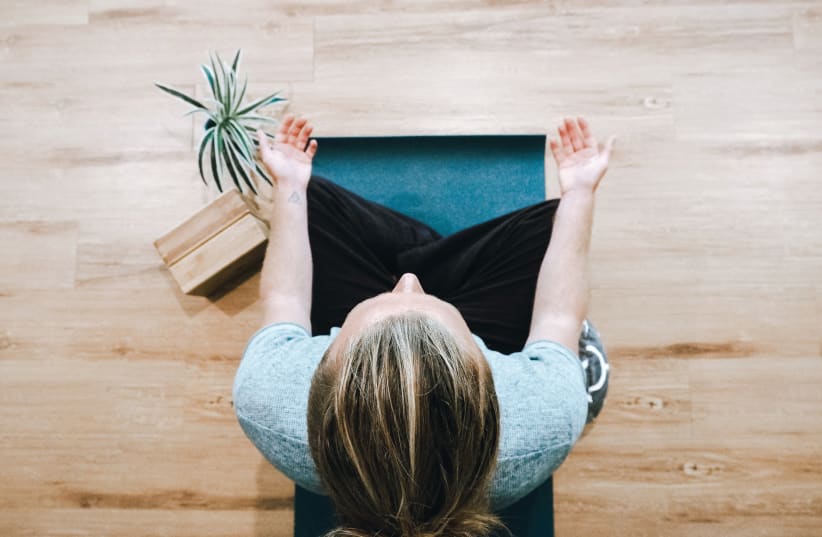It’s not that often that I’m able to see my spouse in action professionally.
The Wife is a psychotherapist – my standing joke when asked what she does is to say she is a “psycho (long pause) therapist” – and mindfulness instructor. So my chances of seeing her at work are slim. I mean, it’s not as if I can just sit in on one of her therapy sessions with a client.
I know she’s good at what she does because I know her as someone very sympathetic, empathetic, compassionate and kind. But I’ve never actually seen her use her skills in a professional capacity.
So I was very happy to be included in an invitation she received to present and lead sessions on mindfulness at a recent conference for fellow therapists near Lake Kinneret (the Sea of Galilee). I was thrilled for two reasons, listed here in no particular order: two free nights at a hotel (people love free things), and being able to watch The Wife do what she does.
And I was not disappointed, neither by the two free nights nor by observing The Wife in action.
BUT FIRST, some words about mindfulness.
From what I’ve gleaned from conversations with The Wife over the years, mindfulness aims to keep you in the present: not always thinking about what was or worried about what will be, but instead focusing on what is happening right now.
And I mean right now.
If you’re walking, focus on that next step you are taking; if you are eating, savor that bit of food you are chewing. It all has to do with being in, and appreciating, the here and now. And it also involves a lot of breathing and meditation.
In other words, being mindful is pretty much everything I’m not, except for the breathing – I’ve mastered breathing.
I constantly ruminate about the past and worry endlessly about the future. When I walk, I don’t think about the next step but rather about why I’m late. And when I eat lunch, I’m not thinking about that food item in my mouth at that moment – its smell, texture, taste and even its sound – but instead wondering what I’m going to eat for dinner.
No, I’m not mindful at all, which is interesting considering I am married to someone who very much is. Over the years, we’ve reached a healthy balance: I leave her alone when she lives in the moment and practices what is called in the lingo “self-compassion” (being as kind to yourself as you would be to a friend), and she lets me alone when I fret about the past, worry about the future and engage in bouts of self-flagellation.
Or, as I once explained to my father, I’ve got my schtick; she’s got hers. She puts up with mine – and my schtick is objectively more annoying than paying attention when you eat – and I put up with hers.
It was an eye-opener, therefore, seeing her leading mindfulness sessions and watching people respond.
IF I could trace The Wife’s journey into mindfulness, I would trace it to Passover Seders years ago, when our four children were quite young.
To make the Seders more meaningful, The Wife would lead what she called guided imagery, which is kind of a distant cousin of mindfulness. While talking about the Exodus, she would tell us all to close our eyes, and then she would paint a very graphic picture with her voice of the Jews slaving under the blistering Egyptian sky, building one of those pyramids in Ramses.
The audience, our nuclear family, was a tough sell. When she said we should all close our eyes, she and The Youngest child – who at that time aimed to please his mother – were the only ones who did. Everyone else, myself included, faked it, peeking out of one eye to see what the others were doing.
So when The Wife led that mindfulness session at the retreat and said everyone should close their eyes, I fell back into old patterns and kept one eye open, half expecting that most of the 50 other people in the room would be doing the same.
But I was wrong. I was struck by the degree to which all in the room – unlike me and my children way back when – did as they were told. The exercise was called a body scan, checking in mentally with the different parts of the body to feel the various sensations and become grounded. Everyone was engaged: eyes closed, two feet on the floor, breathing, checking in with their shins and shoulders.
I was impressed. The Wife very much knew what she was doing, and the crowd was dutifully following her directions. And afterward she did something I would never do: she asked for feedback, or as they call it in these settings, “sharing.”
Me, I’m not a feedback or sharing kind of guy. Sure, I love getting positive feedback but am less fond of the negative variety. So I rarely invite feedback, true to one of the mottos I live by: “Don’t ask questions you don’t want to hear the answer to.”
But The Wife, more courageous, asked people to share. The feedback was overwhelmingly positive, and – like a proud parent – I kvelled.
Then came the after-session when folks approached the speaker. They also approached me, telling me how good she was and how lucky I was to be married to her.
I agreed, though not necessarily because she runs a mean mindfulness session.
One woman came up to me and said that being married to someone so proficient in mindfulness must make me very calm and relaxed.
Here’s what I wanted to say: “Does someone married to a dentist necessarily have good teeth? Is the wife of a mathematician good at algebra? Does the husband of a physical therapist have good posture? No, I’m not calm. In fact, I’m stressed out as hell.”
“Does someone married to a dentist necessarily have good teeth? Is the wife of a mathematician good at algebra? Does the husband of a physical therapist have good posture? No, I’m not calm. In fact, I’m stressed out as hell.”
What Herb Keinon wanted to say
But I didn’t say that. “Sure, I replied, “I’m as calm as can be.”
“I’m as calm as can be.”
What Herb Keinon actually said
And then I whispered to The Wife: “at least after spending two free nights – meals included – in a hotel by the water.”

